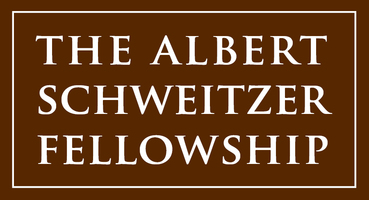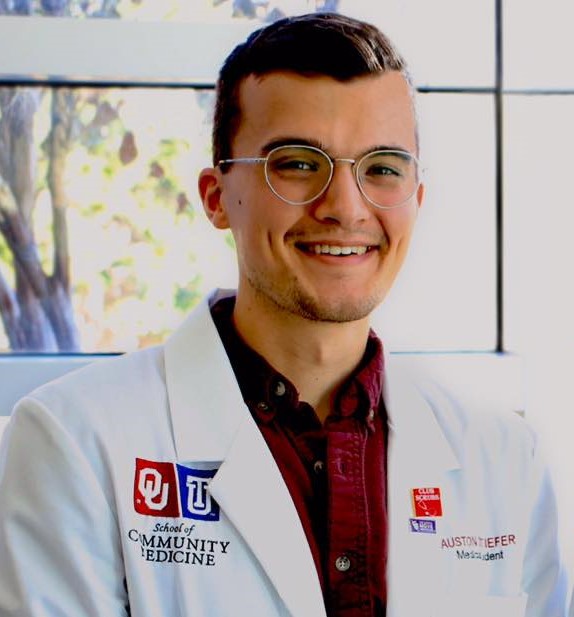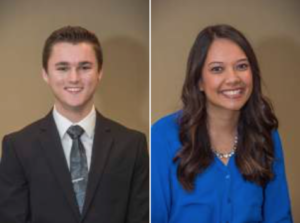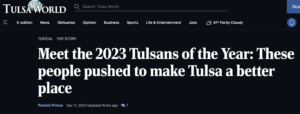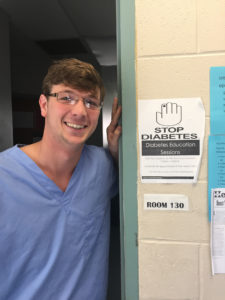By Austin Stiefer, Fellow 2021-22, MS-IV OU-School of Community Medicine
“Listen mijo, if my job’s gonna make me get the shot, I at least want to get it here.”
The bustling of students in the charting area and rustling of patients moving to their exam rooms slowly calms on the other side of the door while we talk. It’s a typical Tuesday night at Bedlam Clinic, the free student-run, faculty-supervised clinic at the University of Oklahoma (OU). Bedlam provides care to Tulsa’s uninsured. Twice weekly, like clockwork, patients arrive by 5:00pm sharp, filling the rooms of the daytime Family Medicine clinic. Alongside patients, students arrive at 5:00pm, replacing the resident physicians and nurses who are leaving for the day. The space is abuzz again with an injection of nocturnal energy. During my second year of medical school, I began volunteering as a medical interpreter for Bedlam patients who speak only Spanish. A year later during my third year clinical rotations, I got to see patients on my own, under faculty supervision
I’ve returned to Bedlam for my third consecutive year, this time as a fourth year medical student and Albert Schweizer Fellow. As a Schweitzer Fellow, I’ve designed an initiative to promote health literacy among Bedlam’s Spanish-speaking patients, in particular about vaccines. The Bedlam patient population has shifting demographics. After months of hiatus during the pandemic, the clinic’s reopening in late 2020 coincided with Medicaid expansion in Oklahoma and the subsequent departure of patients to other providers because they had become eligible for insurance. Bedlam has remained a bastion for the uninsured, namely the largely Spanish-speaking and often undocumented immigrant communities of Tulsa who are still excluded from Medicaid expansion.
Tonight, I find myself talking to Mariana. A mother of six adult children, she works at a factory producing HVAC filters during physically demanding 12-hour shifts, five days each week. Mariana is on her feet without sitting for these 12-hour days, her arms in constant motion manipulating machinery. She is physically exhausted by the time she returns home late each night. Mariana came to the US in her early 20s and still regrets that she was never able to pursue higher education, because she had to care for her ill parents. “Pero te prometo que fui becada. But I promise you I had scholarships.” After interpreting for Mariana during her clinic visit with a medical student, I remain in her room while she waits on medications. She tells me she has not yet gotten her Covid-19 vaccination.
At the advent of the Covid-19 pandemic in early 2020, the Hispanic/Latinx immigrant populations within the US were primed to be at particularly high risk for contracting the disease. In 2019, the CDC estimated that only 38% of persons identifying as Hispanic/Latinx in the US received the influenza vaccination. This ethnic/racial group had the third-highest rates of flu-related hospitalizations in the same year.[1] Political decisions related to immigration and Medicaid eligibility [2], alongside the high numbers of Hispanic/Latinx Americans working in essential services during the first summer of the pandemic compounded even further the risk of Covid-19 exposures and poorer outcomes experienced by this population. A 2020 CDC report found that the ethnic group in the US with the largest reported excess mortality (ie “the percentage of increase in persons who have died relative to the expected number of deaths for a given place and time”) among those aged 25-64 years was among Hispanic persons.[3]
Themes in the stories Mariana tells me are ones that I’ve found to be common motifs in the narratives of those I’ve met at Bedlam during my time this year as an Albert Schweitzer Fellow. For Mariana, like many, not having yet been vaccinated is the natural result of a constellation of social factors.
“I’m the type of person who really tries to help others – my family all depends on me, you know? So, I listen to everything I can. How else can you be informed?”
Mariana tells me that she’s had daily conversations with her friends, cousins, and others in her life, who are unable to answer questions about Covid-19. She tells me that for every person she hears on the local news describing the benefits and protection offered by the Moderna and Pfizer vaccines, she’s met someone who tells her about health concerns or lost loved ones ostensibly caused by vaccine doses. Common to the factors affecting Mariana’s understanding of the vaccine, the barriers to health literacy among immigrant communities include language, racial discrimination, and limited heath systems knowledge.[4] Mariana herself comments on the lack of consistency in the answers she finds during frequent Google searches. The only thing worse than the scarcity of sources in original Spanish is the inability to appraise dubious information sources from those of greater credibility. Mariana had been inundated with these equivocal and contradictory information sources.
But now, the time had come that Mariana’s place of work is considering vaccination requirements for all employees, given the physical proximity necessary for the daily factory operations. And although she still had questions about the vaccine that she wants to discuss at this clinic visit, Mariana tells me she trusts us at Bedlam and would only get her vaccination with OU-Physicians. Bedlam is been the only place she’d been able to have consistent medical care prior to the pandemic. “I have to keep working to take care of my family. And if I have to do this to keep working, where else would I go?”
Mariana is not alone in finding herself now ready to get her Covid-19 vaccine. While the summer of 2020 saw the largest share of excess mortality among US Hispanic/Latinx adults, the summer of 2021 saw the largest increase in vaccination among this population. After being 2.3 times as likely as their non-Hispanic counterparts to die of Covid-19 and experiencing a decrease in life expectancy of three years in 2020, Hispanic Americans disproportionately affected by the pandemic had tremendous motivation to receive vaccination in 2021.[5] In September of this year, 73 percent of Hispanic adults in the US were either partially or fully vaccinated against coronavirus, reflecting a 12 percent increase in the proportion of vaccinated individuals in this group since July.[5] Health reporters and public health officials have frequently commented on the role of community outreach in promoting vaccination. Partnerships with nearly every sort of community organization imaginable, including faith-based groups, neighborhood soccer leagues, and local newspapers have contributed to increased vaccination rates.[6,7] And in its own small way, I hope that my time as an Albert Schweitzer Fellow spent promoting health literacy on vaccination has contributed to these much larger efforts.
My Schweitzer Fellowship project began with a fascination for how non-English speakers navigate the complex information-scape during a time of rapidly changing scientific knowledge, medical recommendations, and new technologies. However, my central interest has shifted to the sheer importance of trust. Experiences with patients like Mariana highlight that health behaviors are not simply changed by education. Trust is the bridge between individuals from marginalized communities and their healthcare teams that lead to behavior changes contributing to improved health outcomes. I am consistently awestruck by the level of emotional intimacy health care providers can develop with our patients simply by creating intentional space for discussion on controversial and sensitive topics.
Not only have I seen trust change the behaviors of my participants, but I too have been changed by these moments. I will carry the trust and relationships formed with people like Mariana who’ve I’ve met during my Schweitzer Fellowship year as I graduate in the spring and continue my training as a resident physician. Much more complicated than sheer language barriers or access to medical care, the experiences of marginalized immigrant communities are always intersectional, often traumatic, and at times inaccessible to those without shared experience. Thus, improving disparate health outcomes requires an attention to these multifaceted lived experiences that can only be obtained through building genuine relationships. I will use the relationships I’ve already built this year to educate others about the complexities of immigrant health throughout my career, as I continue developing new relationships and seek further opportunities to reduce immigrant health disparities.
Auston’s Fellowship was made possible by a grant from Ascension St. John.
[1] Flu disparities among racial and ethnic minorities. Centers for Disease Control and Prevention. Oct 2020. https://www.cdc.gov/flu/highrisk/disparities-racial-ethnic-minority-groups.html
[2] Tolbert J, Artiga S, Pham O. Impact of Shifting Immigration Policy on Medicaid Enrollment and Utilization of Care among Health Center Patients. Kaiser Family Foundation. www.KFF.org. 15 Oct 2019.
[3] Rossen L, Ahmad F, Anderson R, et al. Disparities in Excess Mortality Associated with Covid-19 – United States, 2020. CDC Morbidity and Mortality Weekly Report (MMWR). https://www.cdc.gov/mmwr/volumes/70/wr/mm7033a2.htm 20 Aug 2021.
[4] Baumeister A, Aldin A, Chakraverty D, Monsef I, Jakob T, Seven ÜS, Anapa G, Kalbe E, Skoetz N, Woopen C. Interventions for improving health literacy in migrants. Cochrane Database of Systematic Reviews 2019, Issue 4. Art. No.: CD013303.
[5] Medina E. A large share of Hispanic adults in the US got vaccinated over the summer, a survey shows. New York Times. 29 Sept 2021.
[6] Evans A, Webster J, Flores G. Partnering with the Faith-based Community to Address Disparities in Covid-19 Vaccination Rates and Outcomes Among US Black and Latino Populations. Journal of the American Medical Association. 2021;326(7):609-610
[7] Pratt T. Covid Vaccinations among US Latinos are Rising Thanks to Community Outreach. The Guardian. 19 Sept 2021.
